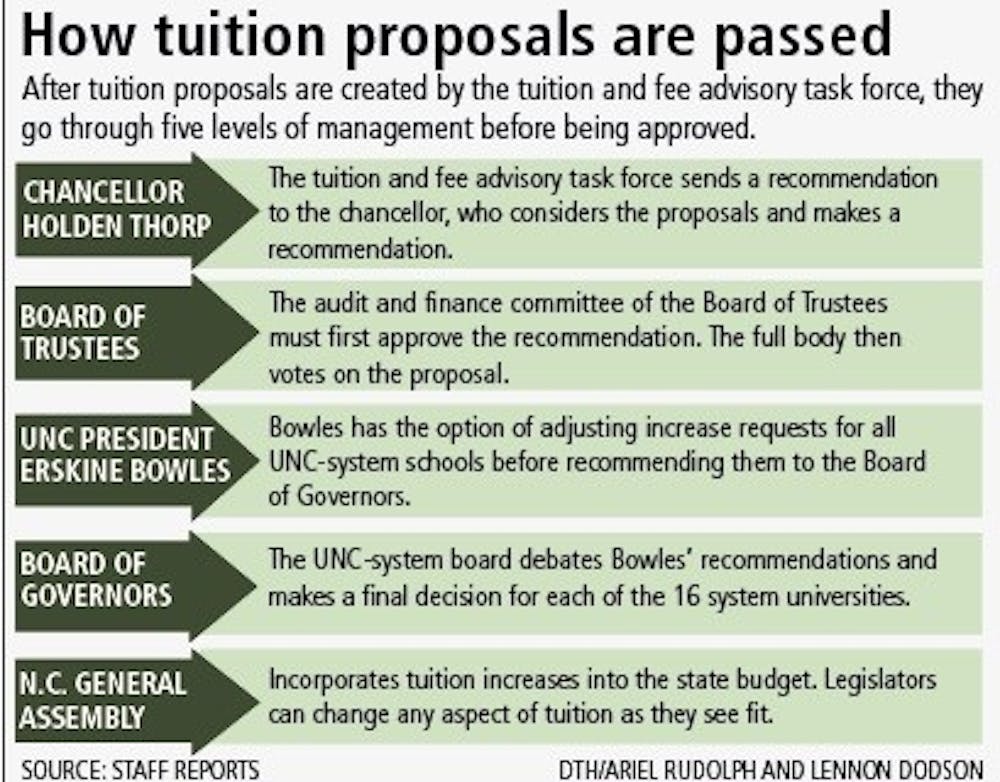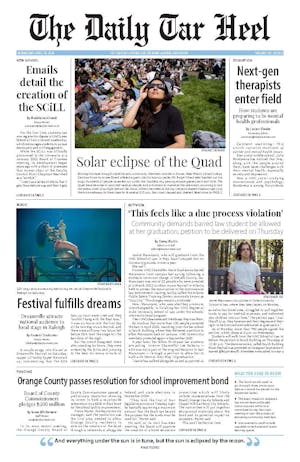This article was published in the 2009 Year in Review issue of The Daily Tar Heel.
The tuition increase proposal Chancellor Holden Thorp sent to UNC-system President Erskine Bowles might leave campus with financial difficulties.
But administrators said it is a show of commitment to higher education access and a history of low cost compared to peer schools.
In the face of rising costs of educating students and decreased state funds, administrators were faced with a choice: raise tuition as a means of filling a growing budget deficit or keep costs low with students in mind.
They took a middle road that raised undergraduates’ tuition by 5.2 percent for the 2010-11 academic year, the lower of two proposals they considered.
Out-of-state graduate student tuition increased by 3.7 percent, except for departments that already had increases approved by the Board of Governors. In-state graduate students, like undergraduates, will see their tuition increase by $200, as mandated by state law.
Administrators cited concern for affordability in their decision, but many have said the lower increase will present a serious financial challenge for the University.
Several members of the Board of Trustees — which passed the tuition proposal in November — said they foresee a necessary shift away from the University’s low tuition model in the future if UNC is to remain competitive with other top public universities. Most of UNC’s peer group of top public research universities charge much higher tuition rates.
“I am really, really concerned about what we’re doing with tuition,” said John Ellison, who has served as a trustee since 2003, at November’s meeting. “There is a huge disparity between our tuition and that of our peers. It’s getting wider and wider.”
UNC has been able to keep its tuition low because it derives a much larger share of its budget from state appropriations than its peer schools.
Administrators and faculty members on the tuition and fee advisory task force, the body in which the proposal originated, had strongly suggested raising tuition at a greater percentage increase for out-of-state students at the meeting. But this proposal proved unpopular with students, who demanded equal percentage increases for all undergraduates.
Student Body President Jasmin Jones and Vice President David Bevevino, the two undergraduates on the task force, advocated for equal, lower percentage increases, a proposal Thorp eventually adopted.
“I did appreciate the fact that student leaders stood up for us in there,” said freshman Nicole Pradel, who attended that task force meeting.
Administrators have approved a one-time earmark of 50 percent of the revenue gained from tuition increases to financial aid, an area that has seen increased demand in the economic downturn.
The University saw a 23 percent increase in the number of students qualifying for aid this year. There was also a dramatic increase in the number of students who submitted financial aid applications.
“It was unlike any other year we’ve ever had,” said Shirley Ort, director of the Office of Scholarships and Student Aid, in November.
Ort has indicated that if her office does not receive enough funding from tuition increases, the University will have to distribute more financial aid in the form of loans and work-study than grants, which is money that does not need to be paid back. Ort said the office needs about $13 million this year to keep grants at the same level.
Tuition increases will also fund graduate student aid, student services and faculty retention — all priorities that administrators have said might be hard to fund under the 5.2 percent increase.
N.C. lawmakers mandated an increase of $200 on all students, then directed that to the state’s budget. Tuition increases historically have stayed within the University.
Bowles said he will lobby the legislature to give back at least 50 percent of the revenue generated by the $200 increase. Those funds would help make up for the $12 million less in need-based financial aid the UNC system received this year.
The $200 from every student at UNC-CH totals about $5.3 million.
Each UNC-system school’s tuition proposal is expected to be submitted to General Administration by Dec. 18. Bowles and UNC-system Vice President for Finance Rob Nelson will then review the proposals.
The UNC-system Board of Governors, the last stop before the state legislature, will review the proposals in January and reach a decision in February.
Tuition rates will not be finalized until approved by N.C. General Assembly, meaning that students might not know the cost of tuition until well into the summer.
Contact the University Editor at udesk@unc.edu.



